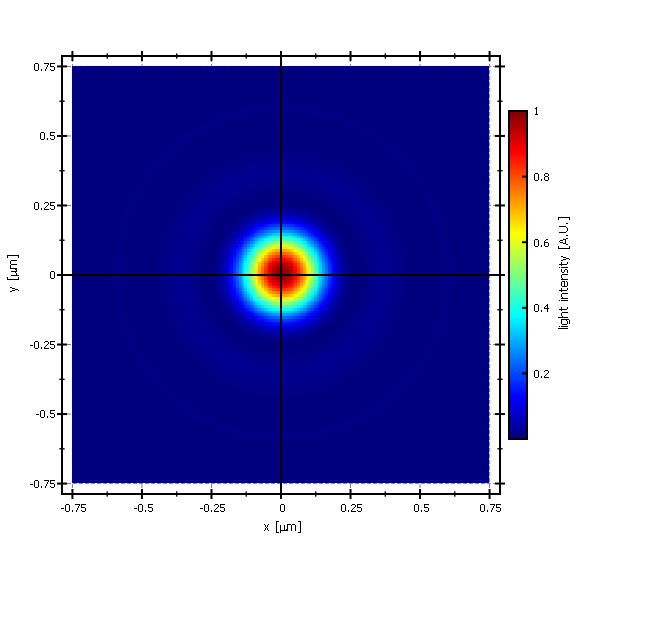mirror of
https://github.com/jkriege2/JKQtPlotter.git
synced 2024-12-26 02:21:43 +08:00
128 lines
6.2 KiB
Markdown
128 lines
6.2 KiB
Markdown
# Example (JKQTPlotter): Simple math image plot, showin a 1-channel OpenCV cv::Mat {#JKQTPlotterImagePlotOpenCV}
|
|
This project (see `./examples/imageplot_opencv/`) simply creates a JKQTPlotter widget (as a new window) and adds a color-coded image plot of a mathematical function (here the Airy disk). The image is generated as an OpenCV `cv::Mat` (see https://opencv.org/) image and then copied into a single column of the internal datastore (JKQTPMathImage could be directly used without the internal datastore).
|
|
To copy the data a special OpenCV Interface function `JKQTPCopyCvMatToColumn()` is used, that copies the data from a cv::Mat directly into a column.
|
|
|
|
The function `JKQTPCopyCvMatToColumn()` is available from the (non-default) header-only extension from `jkqtplotter/jkqtpinterfaceopencv.h`. This header provides facilities to interface JKQTPlotter with OpenCV. The OpenCV-binding itself is header-only, and NOT compiled into the JKQtPlotter libraries. Therefore you can simply include the header and use the facilities provided by it.
|
|
|
|
The CMake-build system of JKQtPlotter (and its examples) is compatible with both OpenCV 3.4.x and 4.x and uses the standard `find_package(OpenCV)` facilities provided by OpenCV to compile and bind against that library.
|
|
If you want to build the OpenCV-based JKQtPlotter examples (see list above), you either have to ensure that CMake finds OpenCV by itself (i.e. somewhere in the default search paths), or you can set the CMake variable `OpenCV_DIR` so it points to the OpenCV directory before configuring JKQtPlotter.
|
|
|
|
|
|
The source code of the main application is (see [`imageplot_opencv.cpp`](https://github.com/jkriege2/JKQtPlotter/tree/master/examples/imageplot_opencv/imageplot_opencv.cpp):
|
|
```.cpp
|
|
#include <QApplication>
|
|
#include <cmath>
|
|
#include "jkqtplotter/jkqtplotter.h"
|
|
#include "jkqtplotter/graphs/jkqtpimage.h"
|
|
#include "jkqtplotter/jkqtpinterfaceopencv.h"
|
|
#include <opencv/cv.h>
|
|
|
|
#ifndef M_PI
|
|
#define M_PI 3.14159265358979323846
|
|
#endif
|
|
|
|
|
|
int main(int argc, char* argv[])
|
|
{
|
|
QApplication app(argc, argv);
|
|
|
|
JKQTPlotter plot;
|
|
|
|
|
|
// 1. create a plotter window and get a pointer to the internal datastore (for convenience)
|
|
plot.getPlotter()->setUseAntiAliasingForGraphs(true); // nicer (but slower) plotting
|
|
plot.getPlotter()->setUseAntiAliasingForSystem(true); // nicer (but slower) plotting
|
|
plot.getPlotter()->setUseAntiAliasingForText(true); // nicer (but slower) text rendering
|
|
JKQTPDatastore* ds=plot.getDatastore();
|
|
|
|
|
|
// 2. now we create data for the charts (taken from https://commons.wikimedia.org/wiki/File:Energiemix_Deutschland.svg)
|
|
cv::Mat airydisk(150, 150, CV_64FC1); // OpenCV-Image for the data
|
|
const double dx=1e-2; // size of a pixel in x-direction [micrometers]
|
|
const double dy=1e-2; // size of a pixel in x-direction [micrometers]
|
|
const double w=static_cast<double>(airydisk.cols)*dx;
|
|
const double h=static_cast<double>(airydisk.rows)*dy;
|
|
|
|
// 2.1 Parameters for airy disk plot (see https://en.wikipedia.org/wiki/Airy_disk)
|
|
double NA=1.1; // numerical aperture of lens
|
|
double wavelength=488e-3; // wavelength of the light [micrometers]
|
|
|
|
// 2.2 calculate image of airy disk in a row-major array
|
|
double x, y=-h/2.0;
|
|
for (int iy=0; iy<airydisk.rows; iy++ ) {
|
|
x=-w/2.0;
|
|
for (int ix=0; ix<airydisk.cols; ix++ ) {
|
|
const double r=sqrt(x*x+y*y);
|
|
const double v=2.0*M_PI*NA*r/wavelength;
|
|
airydisk.at<double>(iy,ix) = pow(2.0*j1(v)/v, 2);
|
|
x+=dx;
|
|
}
|
|
y+=dy;
|
|
}
|
|
|
|
|
|
// 3. make data available to JKQTPlotter by adding it to the internal datastore.
|
|
// In this step the contents of one channel of the openCV cv::Mat is copied into a column
|
|
// of the datastore in row-major order
|
|
size_t cAiryDisk=JKQTPCopyCvMatToColumn(ds, airydisk, "imagedata");
|
|
|
|
|
|
// 4. create a graph (JKQTPColumnMathImage) with the column created above as data
|
|
// The data is color-coded with the color-palette JKQTPMathImageMATLAB
|
|
// the converted range of data is determined automatically because setAutoImageRange(true)
|
|
JKQTPColumnMathImage* graph=new JKQTPColumnMathImage(&plot);
|
|
graph->setTitle("");
|
|
// image column with the data
|
|
graph->setImageColumn(cAiryDisk);
|
|
// set size of the data (the datastore does not contain this info, as it only manages 1D columns of data and this is used to assume a row-major ordering
|
|
graph->setNx(airydisk.cols);
|
|
graph->setNy(airydisk.rows);
|
|
// where does the image start in the plot, given in plot-axis-coordinates (bottom-left corner)
|
|
graph->setX(-w/2.0);
|
|
graph->setY(-h/2.0);
|
|
// width and height of the image in plot-axis-coordinates
|
|
graph->setWidth(w);
|
|
graph->setHeight(h);
|
|
// color-map is "MATLAB"
|
|
graph->setColorPalette(JKQTPMathImageMATLAB);
|
|
// get coordinate axis of color-bar and set its label
|
|
graph->getColorBarRightAxis()->setAxisLabel("light intensity [A.U.]");
|
|
// determine min/max of data automatically and use it to set the range of the color-scale
|
|
graph->setAutoImageRange(true);
|
|
// you can set the color-scale range manually by using:
|
|
// graph->setAutoImageRange(false);
|
|
// graph->setImageMin(0);
|
|
// graph->setImageMax(10);
|
|
|
|
|
|
// 5. add the graphs to the plot, so it is actually displayed
|
|
plot.addGraph(graph);
|
|
|
|
// 6. set axis labels
|
|
plot.getXAxis()->setAxisLabel("x [{\\mu}m]");
|
|
plot.getYAxis()->setAxisLabel("y [{\\mu}m]");
|
|
|
|
// 7. fix axis and plot aspect ratio to 1
|
|
plot.getPlotter()->setMaintainAspectRatio(true);
|
|
plot.getPlotter()->setMaintainAxisAspectRatio(true);
|
|
|
|
// 8 autoscale the plot so the graph is contained
|
|
plot.zoomToFit();
|
|
|
|
// show plotter and make it a decent size
|
|
plot.show();
|
|
plot.resize(600,600);
|
|
plot.setWindowTitle("JKQTPColumnMathImage");
|
|
|
|
|
|
return app.exec();
|
|
}
|
|
|
|
```
|
|
The result looks like this:
|
|
|
|

|
|
|
|
See [`examples/imageplot`](https://github.com/jkriege2/JKQtPlotter/tree/master/examples/imageplot) for a detailed description of the other possibilities that the class JKQTPColumnMathImage (and also JKQTPMathImage) offer with respect to determining how an image is plottet.
|
|
|